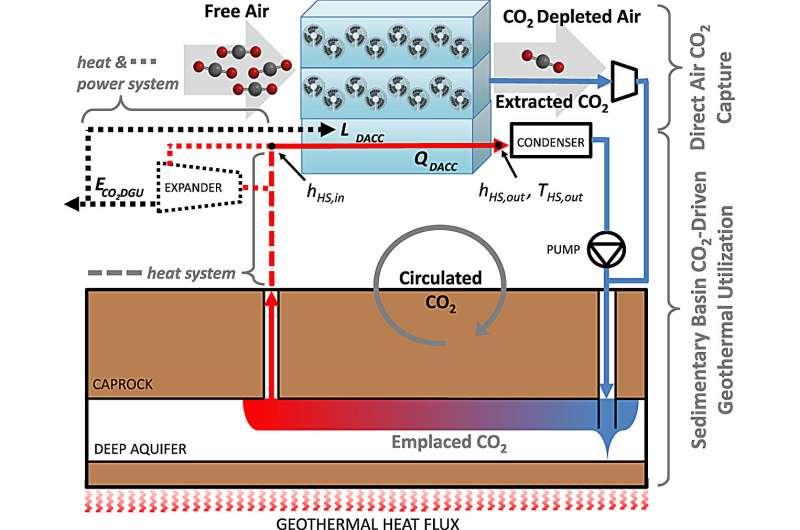This article has been reviewed according to Science X's editorial process and policies. Editors have highlighted the following attributes while ensuring the content's credibility:
fact-checked
peer-reviewed publication
trusted source
proofread
A geothermal-powered, climate-friendly way to capture carbon dioxide in the air

In a new study, researchers have developed a method for capturing carbon dioxide from the atmosphere, powered by clean and relatively inexpensive geothermal energy.
Their findings, published in the journal Environmental Research Letters, reveal that by combining direct air carbon dioxide capture technologies (DACC) and geothermal energy, large-scale carbon dioxide (CO2) removal systems could potentially be supplied with enough energy to remove carbon dioxide from the atmosphere and safely store it underground.
Emitted when humans burn fossil fuels for things like heat, electricity and transportation, carbon dioxide accounts for the majority of greenhouse gases emitted by human activities in the atmosphere. Because this accumulation is one of the main drivers of climate change, efforts to address the excess have focused on methods for extracting carbon dioxide, either at the original source of emission or directly from the air.
"Carbon removal technologies are especially helpful in mitigating climate change because we can capture types of emissions that would be hard to cap in other ways," said Martina Leveni, lead author of the study and a postdoctoral scholar in civil, environmental and geodetic engineering at The Ohio State University. "So we thought, could we combine technologies that could be beneficial to one another to meet this goal more efficiently?"
Typical DACC methods can be expensive and require energy to operate, adding more greenhouse gases to the atmosphere, said Leveni. But she set out to investigate if it was possible to integrate the recycled carbon dioxide into the system to make it more efficient.
Called Direct Air CO2 Capture with CO2 Utilization and Storage (DACCUS), Leveni's proposed method uses the natural heat stored beneath the Earth's surface within deep saline aquifers—underground geologic formations containing sedimentary rock and saltwater—to continuously produce renewable energy for DACC systems.
The carbon dioxide captured from the air is isolated in these geologic formations, and part of it can be circulated to extract the geothermal heat. This circulation brings the heat to the surface, where it can either be used directly or converted to electricity to power the system.
Such a system requires a lot of energy, which can often mean more pollution. But it's an issue their work accounts for, said Jeff Bielicki, co-author of the study and an associate professor in civil, environmental and geodetic engineering and the John Glenn College of Public Affairs at Ohio State.
Geothermal energy in general has a very small carbon footprint, and this particular approach is even lower because it uses carbon dioxide, Bielicki said.
To demonstrate the potential of their system, the researchers developed a case study of how it might work in the U.S. Gulf Coast region. They determined that DACCUS could be deployed there to great success, due to it being well-known for having ample geothermal resources.
"The Gulf Coast also has the right geology to safely put carbon dioxide underground and a decent enough heat flux that its geothermal energy could be sufficient to use," said Bielicki. "These characteristics are very favorable."
In order for their system to work, the geothermal heat extraction system first has to be primed, much like a car engine. That takes about five years of storing carbon from point sources, such as factories that emit carbon dioxide, before a DACCUS facility begins extracting the greenhouse gas from the air.
Assuming their system could be operational by 2025, the study suggests its method could start removing carbon by 2030. The researchers estimate there could be as many as 25 DACCUS systems set up in just one of the 27 geologic formations in the Gulf Coast by 2050.
Nevertheless, this study offers hope for our climate future by emphasizing the importance of fusing new ideas and concepts together to better reach a faraway goal, said Leveni. The study suggests that if implemented, this team's work could even help society meet the current goal of limiting Earth's warming, while averting some of the worst consequences of climate change.
"New technologies can enable one another, and in integrating them, we can tackle climate change," said Leveni. "There's a lot of work to be done to take into account technological readiness and the policies needed to make that research happen."
More information: Martina Leveni et al, A potential for climate benign direct air CO2 capture with CO2-driven geothermal utilization and storage (DACCUS), Environmental Research Letters (2023). DOI: 10.1088/1748-9326/ad0924


















